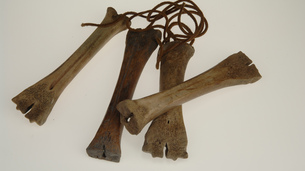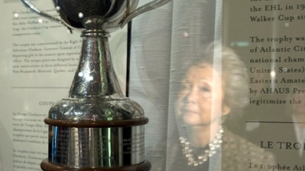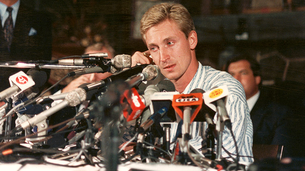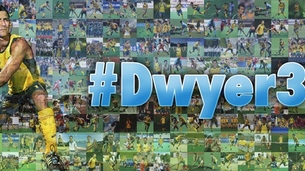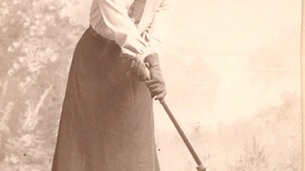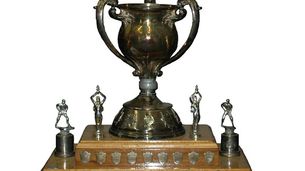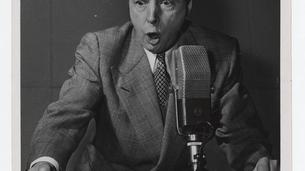The Millionaire Forgotten By the Stanley Cup
Honour Ken Mallen, whose name was left off the coveted trophy 96 years ago.
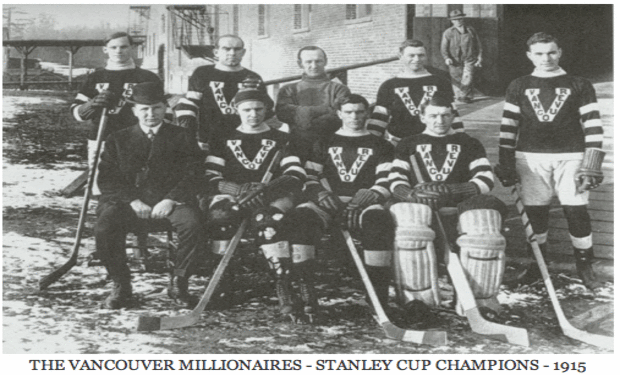

Ken Mallen with the New Westminster Royals in 1912, before he joined the Vancouver Millionaires, who won the Cup in 1915. Credit: City of Vancouver Archives.
The finals seconds ticked off the timekeepers clock, bring an end the the Hockey season, and a championship to a Vancouver club.
The Millionaires, a nickname used in 1915 to praise, not denigrate, a professional athlete, completed a three-game sweep of the Ottawa Senators. The final game ended 12-3, a drubbing that reflected the series.
The skaters retired to their dressing room in the Denman Arena, a hulking brick building overlooking Coal Harbour at the entrance to Stanley Park. Thousands of spectators had clamored to get into the rink for the games, the swells amongst them dropping a stiff $1.25 for a pasteboard to the best seats. Others made do with a 50-cent admission for a rush seat in the steeply-sloped upper deck. Special streetcars delivered fans to the arena. A hardy handful rode the intercity railway from as far afield as Chilliwack, a three-hour milk-run journey that departed at 5 p.m. and brought them home at 2:30 a.m.
In the bowels of the building, the celebrating Vancouver players were joined by their rivals, who crowded in to offer congratulations. "You have a great team here," Ottawa manager Frank Shaughnessy said.
The victory meant the Millionaires had claimed rights to a silver punchbowl purchased for 10 guineas (about $50) in London and on which had been engraved "Dominion hockey challenge cup" and "From Stanley of Preston." It was the first time the Stanley Cup, then 23 years old and already storied, had been won by a team west of Winnipeg.
Alas, the Ottawa side neglected to bring the trophy with them on the transcontinental train trek, "a thoughtless bit of work," as one local reporter noted.
The Cup arrived six weeks later. Later still, an engraver tapped into the silver the names of nine Millionaires, recording for posterity their great achievement.
A tenth player, a veteran forward and a regular during the regular season who skated in two of three games of the finals, was inexplicably overlooked.
Ken Mallen is the man whose name was left off the Stanley Cup.
The Millionaires club
After the finals, the Senators left for Seattle on their way to San Francisco to attend the Panama-Pacific International Exhibition, a showcase for a city devastated nine years earlier by an earthquake and fire.
The Millionaires scattered. Barney Stanley returned home to Edmonton and Jim Seaborn to Winnipeg. The cattle on Lloyd (Farmer) Cook's prairie ranch needed tending. The sure-handed Mickey MacKay, known as the Wee Scot, left for Grand Forks, B.C., where he was to join a survey party for the summer.
Frank (the Pembroke Peach) Nighbor, a gentlemanly player whose brilliant poke-checking drove opponents mad with frustration, departed for the Ontario hometown that gave him his nickname. The goaltender Hugh (Old Eagle Eyes) Lehman returned to Berlin, Ont., an industrial city whose name was soon to be changed from that of an enemy capital to Kitchener, after the British war minister killed in action.
Only four of the Millionaires lived in the Lower Mainland. Frank Patrick played defence and managed the Denman Arena, which he had built four years earlier when he and his brother, Lester, established a professional hockey league on the Pacific Coast.
The great Fred (Cyclone) Taylor served as an immigration inspector. It had been his job the previous year to patrol the Komagata Maru to prevent the passengers, most of them Sikhs, from disembarking. The freighter and its suffering passengers remained moored in Coal Harbour for weeks before being chased off by an armed navy boat, a standoff for which the Canadian prime minister apologized just three years ago.
Si Griffis, the Millionaires' captain who sat out the finals with a broken leg, watching the games from the penalty box, sold advertising for the News-Herald.
Meet Mallen
Mallen spent his work days as a clerk at New Westminster City Hall. He lived at 238 First St., across from Queen's Park, a boarder in a home named Bundahie, built in the style of a classic Edwardian box and owned by a widow who taught piano.
Mallen, a speedy skater, had been lured west by the high contracts on offer by the Patrick brothers in the fledgling Pacific Coast Hockey Association. He was an original member of the New Westminster Royals in 1911, netting 14 goals in 13 games. When the Royals moved to Portland, Ore., he was traded to the Millionaires.
Born in Morrisburg, Ont., he also had two brothers who played professional hockey in the early days. In 1904, the 5'8'', 160-pound skater joined the Calumet (Mich.) Miners of the International Hockey League. Known for his agility and his stickhandling, he netted 38 goals in 24 games to finish second in league scoring.
He quit the Miners soon after the start of his second season to protest the violence of the game. "Realizing that he was one of the best and fastest men in the league, it has been the effort of some players to lay (Mallen) out," reported the Daily Mining Gazette. "Scarcely a game was played but that several times he had to be carried off the ice in an almost unconscious condition."

Ken Mallen's Quebec Bulldogs hockey card. The series of cards was released in 1911-12 and is known as the C55 Imperial Tobacco set.
He eventually wound up wearing the sweaters of the Ottawa Senators and Quebec Bulldogs of the National Hockey Association, the premier pro league in Eastern Canada. His debut in Stanley Cup play came on Jan. 5, 1910, when Ottawa, as holders of the trophy, accepted a challenge from Galt, champions of the Ontario Pro Hockey League. An older brother, Jim, played forward for Galt. The Senators held off their provincial rivals before defeating the Edmonton Eskimos. Ottawa then lost the N.H.A. championship -- and with it the Stanley Cup -- to the Montreal Wanderers.
'Fastest man on ice'
After moving to the coast, Mallen took part in a series of speed races designed to showcase the circuit's high-paid talent. He blew past Griffis and Cyclone Taylor, who had earned his nickname in recognition of his madcap rushes. The triumph cemented Mallen's reputation as the fastest man on ice.
Just as the Stanley Cup champs were about to begin defence of their title, Frank Patrick signed a new star player in Art Duncan of Edmonton. The Millionaires released Mallen, who immediately signed with the Victoria Aristocrats, operated by Lester Patrick. The capital city newspapers were thrilled. "Mallen is the speediest player," noted the Victoria Daily Times. "He possesses a wicked shot, and should add considerable strength in the local attack."
Meanwhile, the N.H.A. and the Patrick league continued raiding players, as skaters regularly jumped contract for more lucrative offers. As well, a battle over rights to the Stanley Cup was fought in boardrooms and on the pages of newspapers. The N.H.A. feared Frank Patrick would not defend challenges for the Stanley Cup. He promised to do so. The Cup's trustees declared the trophy to be emblematic of a world championship, not just a Canadian honour.
It was in that atmosphere that the Cup finally arrived by train in Vancouver on May 12, 1915. (During the six-day journey, the civilian passenger steamer Lusitania was sunk by a German U-boat, killing 1,198.) As N.H.A. champs, Ottawa claimed to be Cup winners, engraving their title on the base. (Their claim to the Cup is not recognized.)
Senseless snub
At the time, the custom was for a championship team to engrave their triumph on the base. Added to the Cup were the words: "VANCOUVER, B.C. / 1914-15 / DEFEATED OTTAWA / 3 STRAIGHT GAMES."
In 1907, the Montreal Wanderers had 20 names of players and club executives engraved on the interior base of the bowl. No other team matched that audacious decision until the Millionaires had engraved on the interior fluting of the bowl the names of nine players.
For some reason, Mallen's name was missed.
The reason for the snub remains unknown. Perhaps he had already left the club by the time of the engraving and so was excluded. Perhaps his departure had not gone well. Perhaps it was inadvertent, a clerical mistake. In any case, Mallen, who died of pneumonia in his hometown in 1930, aged 45, is deserving of the recognition afforded Cyclone and the Wee Scot and Old Eagle Eyes.
The engraving of player names on the trophy only became standard practice after 1924. It is the goal which each of the Vancouver Canucks seeks this month, an honour that has eluded the club for 40 seasons. Should they succeed, they can take a moment while chugging champagne from the bowl to read the names of nine men who beat them to the punch 96 years earlier. ![]()
This article originally posted at thetyee.ca
Mr. Tom Hawthorn can be contacted at theglobeandmail.com

